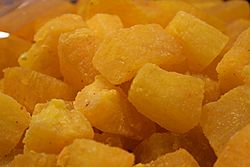Petha facts for kids

Kesar Petha variant
|
|
| Course | Dessert |
|---|---|
| Place of origin | Indian subcontinent |
| Region or state | Agra, Uttar Pradesh |
| Associated national cuisine | Indian cuisine |
| Invented | uncertain |
| Main ingredients | Ash gourd, sugar |
| Variations | Kesar Petha, Angoori Petha, Dry Petha, Chocolate Petha, Paan Petha, Gulab Petha |
| ~250 kcal | |
Petha is a tasty, see-through candy from the Indian subcontinent. It is made from a special vegetable called ash gourd, which is also known as white pumpkin. This sweet treat is very popular, especially in the city of Agra, Uttar Pradesh, India.
How Petha is Made
Petha is made from a large, pale-green vegetable called ash gourd. First, the gourd is cut into small, bite-sized pieces. These pieces are then soaked for a few hours in a special solution made with lime. This lime is not the citrus fruit, but a white powder called calcium hydroxide.
After soaking, the gourd pieces are taken out of the lime solution. They are then boiled until they become soft. Finally, these soft pieces are soaked in a sweet, flavorful syrup. The finished Petha candy has a slightly crunchy outside and a soft, chewy inside.
Today, there are many different kinds of Petha! You can find them in bright colors and flavors. Some popular types include Kesar Petha (saffron flavored) and Gulab Petha (rose flavored). Some even have coconut or nuts mixed in. Sometimes, kewda essence is used to give it a nice smell and taste.
The Story of Petha
Petha has been around for a long time in the Indian subcontinent. It was known by different names, like Oal, in places such as modern-day Jharkhand and Bihar.
There is a popular story that says Petha was first made in the kitchens of the Mughal emperor Shah Jahan. The legend says it was created to feed the workers who were building the famous Taj Mahal. However, this story is probably not true. Old cookbooks from Shah Jahan's time do not mention Petha. Also, there are records of similar dishes existing before the Mughals came to India. Petha is also different from the typical rich, milk-based sweets that Mughals usually enjoyed.
Petha and the Taj Mahal
Agra is a city famous for its Petha, with many small businesses making this sweet for visitors to the Taj Mahal. However, Petha production in Agra has faced a challenge. The government created a special area around the Taj Mahal called the "Taj Trapezium Zone." In this zone, using coal-powered factories is not allowed.
This rule was made to protect the Taj Mahal's white marble. Air pollution can stain the marble. But some local Petha makers use coal to boil their sugar syrup. They argued that this rule made it hard for them to continue their businesses.
Despite this issue, you can still find plenty of Petha in the sweet shops along the roads leading to the Taj Mahal. They are often displayed in bright, colorful rows.

